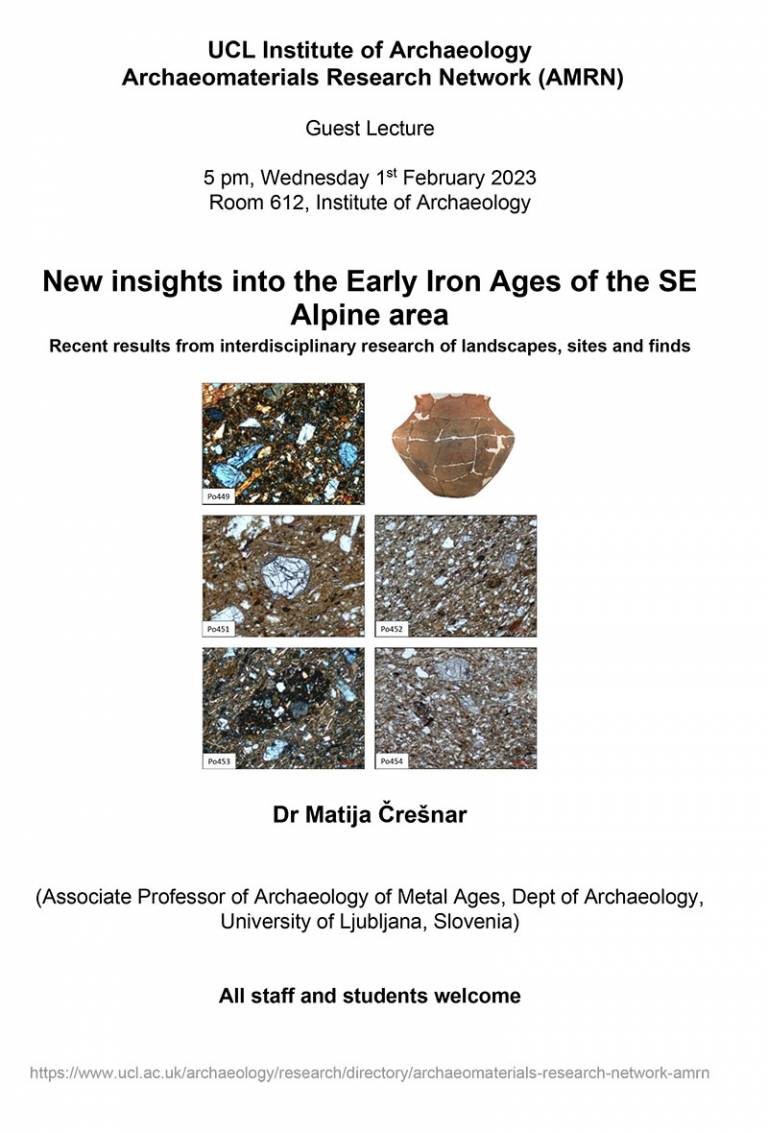New insights into the Early Iron Ages of the SE Alpine area: landscapes, sites and finds
01 February 2023, 5:00 pm–6:00 pm

The Archaeomaterials Research Network (AMRN) will host a talk by Matija Črešnar (University of Ljubljana) at the UCL Institute of Archaeology on 1 February.
This event is free.
Event Information
Open to
- UCL staff | UCL students
Availability
- Yes
Cost
- Free
Organiser
-
Dr Miljana Radivojevic
Location
-
612UCL Institute of Archaeology31-34 Gordon SquareLondonWC1H 0PY
Matija Črešnar (University of Ljubljana) will give a presentation entitled New insights into the Early Iron Ages of the SE Alpine area. Recent results from interdisciplinary research of landscapes, sites and finds.
This hybrid network event will take place on Wednesday 1 February at 5pm in Room 612 of the UCL Institute of Archaeology and also online via Zoom. All staff and students are welcome. Participants wishing to join online should contact Miljana Radivojevic for the Zoom link.
Abstract
Monumental hillforts and extensive burial mound cemeteries are among the most iconic prehistoric features far beyond the SE Alpine area. Their history of research dates back to the work of antiquarians when the first cornerstones of our discipline were laid. They furthermore contributed to the development of the classical toolbox of prehistoric archaeology, which still forms the foundations of our research today. In recent decades, however, a number of new/adapted techniques and methods have been introduced into prehistoric archaeology that are increasingly contributing to a better understanding of its many facets. In my talk, I will focus on the Early Iron Age in the SE Alpine area, i.e. between the fringes of the eastern Alps and the Pannonian plain and try to highlight what the most important new interdisciplinary developments have contributed and how the results have been integrated into the previously established interpretations.
The extensive use of airborne laser scanning (ASL) and geophysical methods has made our largest artefact, the landscapes, much more tangible and understandable. Hillforts and burial mounds are thus no longer discussed as independent monuments but as integral parts of their surroundings. Important progress has also been made with the help of various geoarchaeological methods that help us to understand the complex biographies of prehistoric sites, their parts, but also of individual features and structures more precisely. We will also not forget the detailed analyses of various artefacts and materials, including animal and human skeletal remains, where important new approaches have been established and worked into research strategies. To mention only the latter, it is the stable isotope and genetic studies that have opened new horizons for the understanding of not only the individuals, their familial and other social ties, but also demography on unprecedented scales.
Speaker
Matija Črešnar (PhD 2009) is Assoc. Prof. of Archaeology of Metal Ages at the Department of Archaeology, Faculty of Arts, University of Ljubljana. Since its establishment in 2019, he is also the Chair of the Centre for Interdisciplinary Research in Archaeology (CIRA) at the Department of Archaeology, which aims to promote interdisciplinary and inter-institutional cooperation in the fields of archaeology and cultural heritage. Since 2009, he has also been partially employed at the Institute for the Protection of Cultural Heritage of Slovenia (IPCHS), where he is mainly involved in the management of international projects and collaborations as well as the promotion of archaeological heritage.
In his research, he specializes in Bronze Age and Iron Age studies in Central and South-eastern Europe. The emphasis of his research lies in the intertwining of classical archaeological approaches with several recent technological and methodological developments in the field. The most extensive studies under his direction focus on archaeological landscapes, using remote sensing and geophysics. He is also involved in the analysis of various archaeological materials and human skeletal remains, recently employing stable isotope and genetic analysis. He has (co)published widely on the above topics, including eight edited volumes, dozens of journal articles, book chapters, and articles in conference proceedings, and has organized/contributed to several exhibitions, conferences, sessions etc.
The purpose of the Archaeomaterials Research Network (AMRN) is to organise focused group activities that cross-cut the wide chronological and geographic coverage of UCL archaeomaterials research.
The network's interest includes ceramics, metals, glass, slag, plaster and lithics. In keeping with the Institute's strong profile in scientific materials analysis, the network is particularly interested in archaeometric approaches such as optical microscopy, scanning electron microscopy, and geochemical analysis. However, traditional macroscopic approaches are also incorporated, as well as experimental and ethnographic perspectives. Technology is central to the study of inorganic archaeological materials, which represent synthetic artefacts manipulated by human hands. The interaction of craftspeople with naturally-occurring raw materials and their transformation into functional objects is a rich source of information on the skills, traditions, identities and beliefs of past societies. Another key theme is the movement of artefacts via processes such as trade, exchange and migration. Compositional data can be used to source or provenance archaeological materials and thus reconstruct these and other types of cultural interaction.
Given the importance of inorganic artefacts within the fields of archaeology, conservation and heritage, the network has a deliberately wide remit and a relevance to many Institute of Archaeology staff. Network members also include postdocs, PhD researchers, masters and undergraduate students. Network events include guest and in-house lectures, workshops focused on specific artefact types and approaches, as well as fieldwork and experimental reconstruction.
If you are interested in joining the AMRN or have an idea for a network event, then please contact one of the network co-ordinators:
 Close
Close

